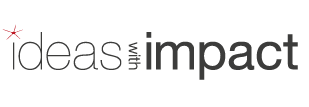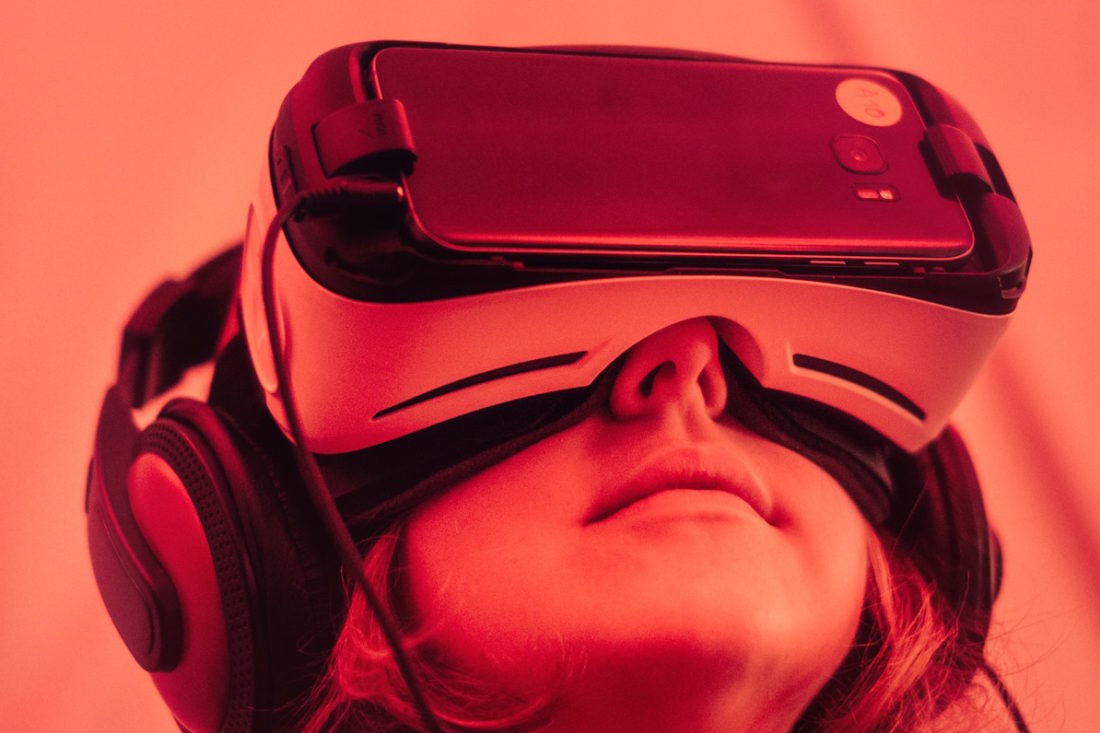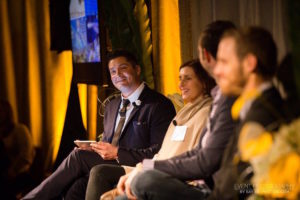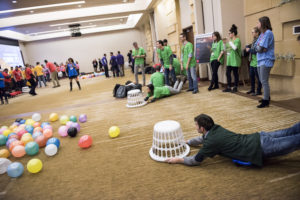When it comes to Technology, Event Professionals Should Think Like Digital Marketers
Last month, CEO Karen DeTemple spoke on a panel called “Lights, Sound, Tech — Event!” with ILEA Northern California, in a talk that focused on the latest trends lighting, audio, visual and computer technology that all event professions should understand.
After a great session, we felt that we had more to share on the topic. This month’s article will be capturing some of the speaking points from that panel, as well as some additional points that event professionals should consider when bringing in technology to any event.
Purposeful Jazz Hands
Sixty-seven percent of CEOs consider their companies to be technology companies, according to Fortune Magazine, “Whether they pump liquids, make machines, mine minerals or print magazines — digitization has become their destiny.”
CEO, Karen DeTemple on the panel of ILEA’s “Lights, Sound, Tech — Events!”
talking about how to meaningfully use technology in event marketing.
If brands are facing continuing pressure to become technology companies, it then follows that as event marketing professionals, our industry needs to cleverly integrate technology into our special events, conference productions, and event activations. At the root of Ideas with Impact’s methodology is consulting with clients to champion their cause by developing the right creative ideation to produce their desired results. And while we are advocates of integrated experiences using technology, we are more invested in creating a technological experience that purposefully adds to the event, not clutters it. We call this being a proponent of not just “jazz hands” but “purposeful jazz hands.”
Many brands have a frenzied feeling when it comes to the live event space, feeling pressure to throw as much technology as possible into the attendee experience. We often see brands gravitate towards ideas that have the “wow factor” such as having an executive on stage utilizing augmented reality or Musion for a keynote presentation. Eye-catching? Yes? A personalized human connection? Not so much.
Digital marketers seem to understand this relationship of personalization extremely well. A consumer can be shopping for an item, and days later receive an email in their inbox that says, “Hi Karen, that sweater you were looking at just went on sale. Would you like to purchase?” This is both personalized and relevant.
So instead of advocating for light up badges, as event professionals we should be taking a cue from our digital marketer counterparts. We should be looking for ways to create a check-in experience that will say, “Hi Karen, welcome back to SUMMIT. We’re thrilled you’re joining us for the fourth year. We noticed that last year you ordered a vegan lunch. Are you going to need a vegan lunch again this year?”
This is a much more personalized experience that utilizes technology in a purposeful way while building connection and loyalty…with no heavy lifting from the attendee.
When to introduce technology?
Most event professionals worth their weight in salt will tell you that typically the challenge is not in talking brands or clients into using technology, but rather talking them out of irrelevant technology. Ideas with Impact has devised a series of questions that we ask our clients as a vetting procedure to ensure that our use of technology is adding to the experience and not cluttering the event.
- What is the emotional purpose? Feelings drive engagement, and there is a desired behavior for every type of engagement brands ask their attendees to complete. Start by asking what you want them to feel, and narrow in on how that impacts the desired behavior.
- Is there a reward? Does this engagement have added experience for the attendee? It should also have a reward for the brand itself (brand evangelization, data collection, etc). Start by thinking about the human, not the technology.
- Is it relevant? Is it approachable? Once a brand understands what they want attendees to feel, how they will engage, and how the action augments the experience for the brand and the attendee, we must double check — is it relevant to the brand and is it approachable to the attendee?
- Does the technology surprise and delight? The final question brands must ask is whether this adds an additional element that creates an unexpected positive experience.
This coming spring, we are producing a Leadership Conference for a Technology company focusing on how their team can lead for change and raise awareness of some of the “futuristic” leaps and bounds that we have seen become a reality. These brand and conference concepts that focus on the future, are a great fit for a“high-tech / high-touch” strategy that introduces participants to various technologies, and gets them engaged. We specifically are proposing to bring in technology that offers a reward, drives engagement, is relevant, surprises and delights.
One of the tools we are suggesting is Tilt Brush, a virtual reality technology that lets participants paint life-size, three-dimensional brush strokes, stars, light, and even fire in 3D space. Because participants get a hands-on opportunity to create in 3D, while bystanders can watch and become engaged in new creations, it is a perfect fit and a great use of technology at this conference.
Low-Tech / No-Tech
Sometimes creating a low-tech / no-tech event can actually be the most memorable experience. When looking back at whether or not an event was impactful, most attendees will tell you about their human experiences, not the tech integrations. Event marketers shouldn’t overlook the power of a no-tech event that leverages old-fashioned games to push an element of experiential learning. Cutting the iPads and power chords while asking attendees to feel and participate with their entire body can add a needed break amidst a very digitally connected world.
For example, one of our clients is a manufacturer for a popular medical product. While they focus on creating exceptional products, their brand’s core focus is helping their customers create a “bright” experience in their lives. So, when debating what kind of technology integration would be beneficial at their conferences, a low-tech/no-tech approach is not only perfectly appropriate, but likely to yield great feedback and better ROI. By focusing the event on reconnection with other humans and creating quality interactions, this client is leveraging their key brand tenants to make smarter choices about their use of technology.
There is a time and place for technology and its not for every brand, every day, all the time. The more event professionals can begin to think like digital marketers by placing the priority on a personalized experience, the more we can create experiences for our clients and their users that yield the most compelling impacts while making the most of their brand investments.
Karen DeTemple is the Founder of Ideas with Impact, a brand communications and event marketing company based in San Francisco. With a background that spans from brand marketing to psychology studies, Karen understands what it takes to motivate people and shift behaviors—for both client teams and her own. Known for her candor and wit, Karen ensures every attendee journey has both big and small moments for people to learn, absorb and take action. Karen is a natural team orchestrator, bringing together the right mix of people, inspiration and process so that everyone can shine to the fullest.





